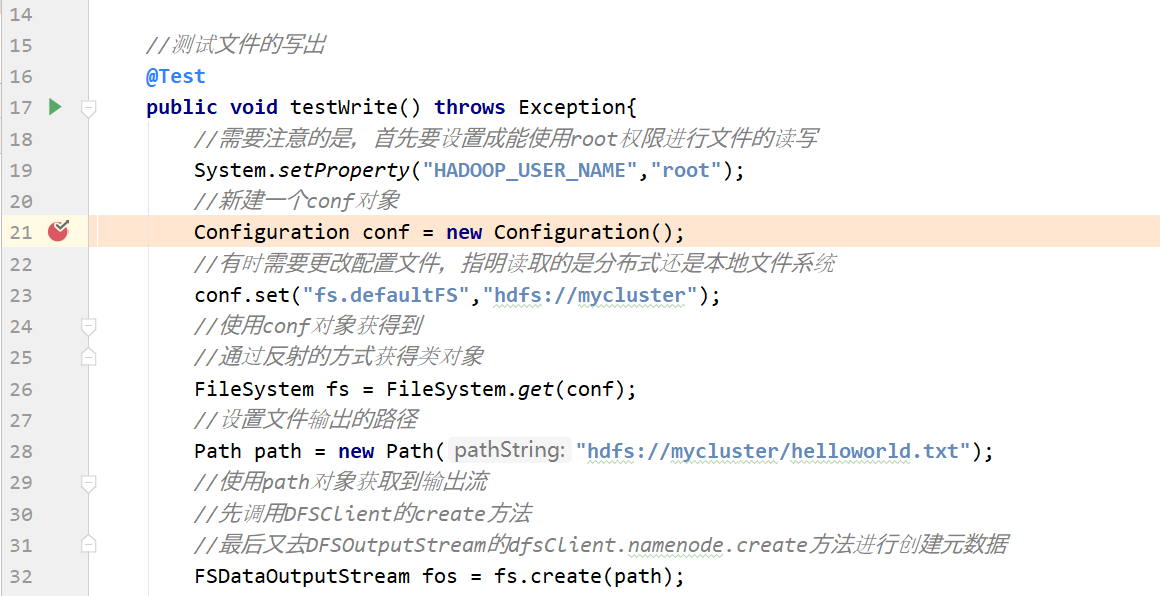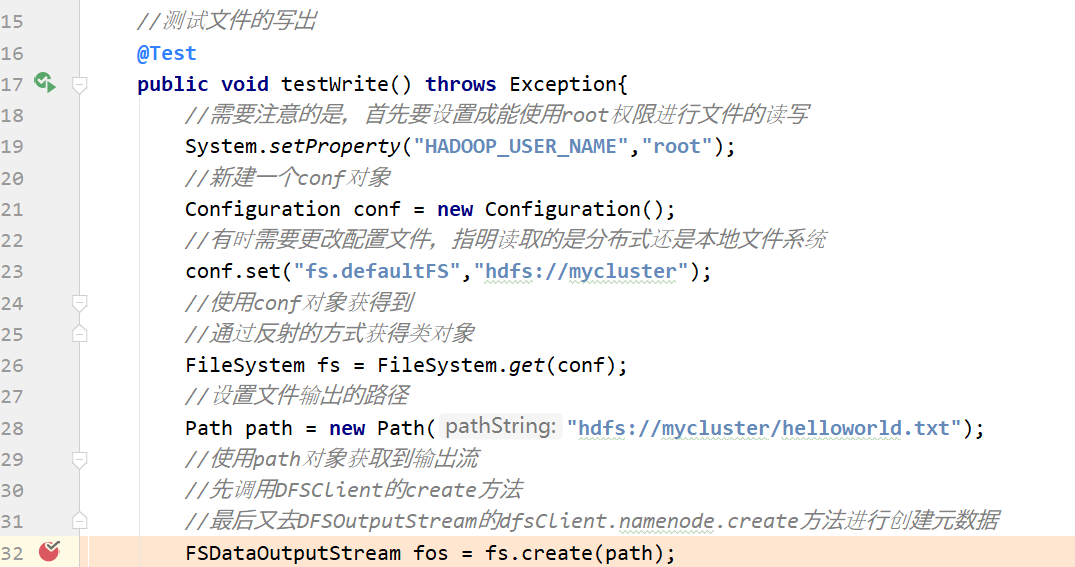HDFS写入过程方法调用逻辑 & 源码注释解读
前一篇介绍HDFS模块的博客中,我们重点从实践角度介绍了各种API如何使用以及IDEA的基本安装和配置步骤,而从这一篇开始,将会正式整理HDFS的读写原理分析,由于全部一次性整理篇幅过长,本人会将这一部分的内容拆分成多篇,这一篇将会从宏观上把控整个写入过程的框架,并啃一啃源码中的注释部分,好了,废话不多说,直接开始吧!
1. 框架图展示

上图摘录自《Hadoop权威指南》,从这张图可知,整个写入过程被分成了七大步骤,在第一篇源码分析博客中,本人会就前三个步骤做一个介绍,分别是HDFS客户端新建一个FileSystem对象,在名称节点上新建元数据,以及新建一个FSDataOutputStream对象
2. 源码解读
2.1 HDFS客户端新建FileSystem对象
这一步操作实际上包含了两个主要步骤:新建一个Configuration对象以及使用FileSystem类的静态方法get方法获取到FileSystem对象
2.1.1 注释文档翻译
首先,我们翻译一下FileSystem类的文档,从宏观上把控这个类:
An abstract base class for a fairly generic filesystem. It
may be implemented as a distributed filesystem, or as a "local"
one that reflects the locally-connected disk. The local version
exists for small Hadoop instances and for testing.
一个通用的文件系统的抽象基类,它可以被应用于一个分布式的文件系统,或者作为一个“本地的”反映了本地磁盘的文件系统而存在,本地化的版本一般比较适合应用于较小的Hadoop实例或用于测试环境
All user code that may potentially use the Hadoop Distributed
File System should be written to use a FileSystem object. The
Hadoop DFS is a multi-machine system that appears as a single
disk. It's useful because of its fault tolerance and potentially
very large capacity.
所有的可能会使用到HDFS的用户代码在进行编写时都应该使用FileSystem对象,HDFS文件系统是一个跨机器的系统,并且是一个单独的磁盘(即根目录)的形式出现的,这样的方式非常有用,是因为它的容错机制和海量的容量
2.1.2 新建Configuration对象
我们将断点打到下图为止,进行调试,来看看新建Configuration对象时究竟发生了些什么

关键代码如下:
static{ //print deprecation warning if hadoop-site.xml is found in classpath ClassLoader cL = Thread.currentThread().getContextClassLoader(); if (cL == null) { cL = Configuration.class.getClassLoader(); } if(cL.getResource("hadoop-site.xml")!=null) { LOG.warn("DEPRECATED: hadoop-site.xml found in the classpath. " + "Usage of hadoop-site.xml is deprecated. Instead use core-site.xml, " + "mapred-site.xml and hdfs-site.xml to override properties of " + "core-default.xml, mapred-default.xml and hdfs-default.xml " + "respectively"); } addDefaultResource("core-default.xml"); addDefaultResource("core-site.xml"); }
由此可见,Configuration对象会加入两个默认的配置文件,core-default.xml以及core-site.xml
2.1.3 获取FileSystem对象
现在我们将断点打到下图位置:

经过方法的层层调用,我们最终找到了FileSystem对象是通过调用getInternal方法得到的
首先在getInternal方法中调用了createFileSystem方法

进入createFileSystem方法,关键的来了!
private static FileSystem createFileSystem(URI uri, Configuration conf ) throws IOException { Class<?> clazz = getFileSystemClass(uri.getScheme(), conf); FileSystem fs = (FileSystem)ReflectionUtils.newInstance(clazz, conf); fs.initialize(uri, conf); return fs; }
原来,FileSystem实例是通过反射的方式获得的,具体实现是通过调用反射工具类ReflectionUtils的newInstance方法并将class对象以及Configuration对象作为参数传入最终得到了FileSystem实例
2.2 在名称节点上新建元数据
2.2.1 注释文档翻译
此步骤一共涉及到这几个类,DistributedFileSystem,DFSClient以及DFSOutputStream
DistributedFileSystem类
Implementation of the abstract FileSystem for the DFS system.
This object is the way end-user code interacts with a Hadoop
DistributedFileSystem.
在分布式文件系统上,抽象的FileSystem类的实现子类,这个对象是末端的用户代码用来与Hadoop分布式文件系统进行交互的一种方式
DFSClient类
DFSClient can connect to a Hadoop Filesystem and
perform basic file tasks. It uses the ClientProtocol
to communicate with a NameNode daemon, and connects
directly to DataNodes to read/write block data.
Hadoop DFS users should obtain an instance of
DistributedFileSystem, which uses DFSClient to handle
filesystem tasks.
DFSClient类可以连接到Hadoop文件系统并执行基本的文件任务,它使用ClientProtocal来与一个NameNode进程通讯,并且直接连接到DataNodes上来读取或者写入块数据,HDFS的使用者应该要获得一个DistributedFileSystem的实例,使用DFSClient来处理文件系统任务
DFSOutputStream类
DFSOutputStream creates files from a stream of bytes.
DFSOutputStream从字节流中创建文件
The client application writes data that is cached internally by
this stream. Data is broken up into packets, each packet is
typically 64K in size. A packet comprises of chunks. Each chunk
is typically 512 bytes and has an associated checksum with it.
客户端写被这个流缓存在内部的数据,数据被切分成packets的单位,每一个packet大小是64K,一个packet是由chunks组成的,每一个chunk为512字节大小并且伴随一个校验和
When a client application fills up the currentPacket, it is
enqueued into dataQueue. The DataStreamer thread picks up
packets from the dataQueue, sends it to the first datanode in
the pipeline and moves it from the dataQueue to the ackQueue.
The ResponseProcessor receives acks from the datanodes. When a
successful ack for a packet is received from all datanodes, the
ResponseProcessor removes the corresponding packet from the
ackQueue.
当一个客户端进程填满了当前的包时,它就会被排入数据队列(dataQueue),DataStreamer线程从数据队列中获取包并在管线将它发送到第一个datanode中去,然后把它从数据队列移动至确认队列(ackQueue),响应处理器(ResponseProcessor)从datanodes中接收确认回执,当一个包成功确认的回执被从所有的datanodes接收到时,响应处理器就会从确认队列中移除相应的数据包
In case of error, all outstanding packets are moved from
ackQueue. A new pipeline is setup by eliminating the bad
datanode from the original pipeline. The DataStreamer now
starts sending packets from the dataQueue.
如果出现错误,所有未完成的包都会从确认队列中移除(同时会将packet移动到数据队列的末尾),通过从原始的管线中消除坏掉的datanode,一个新的管线被重新架设起来,DataStreamer开始从数据队列中发送数据包
2.2.2 新建元数据源码解读
先将断点打到下图位置,然后debug

第一步调试,我们首先进入到的是FileSystem类,经过create方法的层层调用,最终我们找到了出口
public FSDataOutputStream create(Path f, boolean overwrite, int bufferSize, short replication, long blockSize, Progressable progress ) throws IOException { return this.create(f, FsPermission.getFileDefault().applyUMask( FsPermission.getUMask(getConf())), overwrite, bufferSize, replication, blockSize, progress); }
继续调试,我们发现FSDataOutputStream是一个包装类,它是通过调用DistributedFileSystem类的create方法返回的,而查看代码可知,这个包装类所包装的,正是DFSOutputStream!!!于是乎,第二个出口也被我们找到了
@Override public FSDataOutputStream create(final Path f, final FsPermission permission, final EnumSet<CreateFlag> cflags, final int bufferSize, final short replication, final long blockSize, final Progressable progress, final ChecksumOpt checksumOpt) throws IOException { statistics.incrementWriteOps(1); Path absF = fixRelativePart(f); return new FileSystemLinkResolver<FSDataOutputStream>() { @Override public FSDataOutputStream doCall(final Path p) throws IOException, UnresolvedLinkException { final DFSOutputStream dfsos = dfs.create(getPathName(p), permission, cflags, replication, blockSize, progress, bufferSize, checksumOpt); return dfs.createWrappedOutputStream(dfsos, statistics); }
继续调试,我们发现这个DFSOutputStream是从DFSClient类的create方法中返回过来的
public DFSOutputStream create(String src, FsPermission permission, EnumSet<CreateFlag> flag, boolean createParent, short replication, long blockSize, Progressable progress, int buffersize, ChecksumOpt checksumOpt, InetSocketAddress[] favoredNodes) throws IOException { checkOpen(); if (permission == null) { permission = FsPermission.getFileDefault(); } FsPermission masked = permission.applyUMask(dfsClientConf.uMask); if(LOG.isDebugEnabled()) { LOG.debug(src + ": masked=" + masked); } final DFSOutputStream result = DFSOutputStream.newStreamForCreate(this, src, masked, flag, createParent, replication, blockSize, progress, buffersize, dfsClientConf.createChecksum(checksumOpt), getFavoredNodesStr(favoredNodes)); beginFileLease(result.getFileId(), result); return result; }
查看已标记了的关键代码,我们又发现,DFSClient类中的DFSOutputStream实例对象是通过调用DFSOutputStream类的的newStreamForCreate方法产生的,于是乎,我们单步进入这个方法,一探究竟,终于,我们找到了新建元数据的关键代码!!!
static DFSOutputStream newStreamForCreate(DFSClient dfsClient, String src, FsPermission masked, EnumSet<CreateFlag> flag, boolean createParent, short replication, long blockSize, Progressable progress, int buffersize, DataChecksum checksum, String[] favoredNodes) throws IOException { TraceScope scope = dfsClient.getPathTraceScope("newStreamForCreate", src); try { HdfsFileStatus stat = null; // Retry the create if we get a RetryStartFileException up to a maximum // number of times boolean shouldRetry = true; int retryCount = CREATE_RETRY_COUNT; while (shouldRetry) { shouldRetry = false; try { stat = dfsClient.namenode.create(src, masked, dfsClient.clientName, new EnumSetWritable<CreateFlag>(flag), createParent, replication, blockSize, SUPPORTED_CRYPTO_VERSIONS); break; } catch (RemoteException re) { IOException e = re.unwrapRemoteException( AccessControlException.class, DSQuotaExceededException.class, FileAlreadyExistsException.class, FileNotFoundException.class, ParentNotDirectoryException.class, NSQuotaExceededException.class, RetryStartFileException.class, SafeModeException.class, UnresolvedPathException.class, SnapshotAccessControlException.class, UnknownCryptoProtocolVersionException.class); if (e instanceof RetryStartFileException) { if (retryCount > 0) { shouldRetry = true; retryCount--; } else { throw new IOException("Too many retries because of encryption" + " zone operations", e); } } else { throw e; } } } Preconditions.checkNotNull(stat, "HdfsFileStatus should not be null!"); final DFSOutputStream out = new DFSOutputStream(dfsClient, src, stat, flag, progress, checksum, favoredNodes); out.start(); return out; } finally { scope.close(); } }
查看关键代码,我们发现这个stat对象是调用namenode的create方法产生的,而ctrl + 左键点击namenode后发现namenode正是之前注释里面提到的ClientProtocal的一个实例对象,而ClientProtocal是一个接口,它的一个实现子类名字叫做ClientNamenodeProtocalTranslatorPB就是我们想要的,我们找寻这个类的方法,最终发现了create方法!!!而返回值是通过调用rpcProxy的create方法实现的,这里用到的是Google的Protobuf序列化技术
@Override public HdfsFileStatus create(String src, FsPermission masked, String clientName, EnumSetWritable<CreateFlag> flag, boolean createParent, short replication, long blockSize, CryptoProtocolVersion[] supportedVersions) throws AccessControlException, AlreadyBeingCreatedException, DSQuotaExceededException, FileAlreadyExistsException, FileNotFoundException, NSQuotaExceededException, ParentNotDirectoryException, SafeModeException, UnresolvedLinkException, IOException { CreateRequestProto.Builder builder = CreateRequestProto.newBuilder() .setSrc(src) .setMasked(PBHelper.convert(masked)) .setClientName(clientName) .setCreateFlag(PBHelper.convertCreateFlag(flag)) .setCreateParent(createParent) .setReplication(replication) .setBlockSize(blockSize); builder.addAllCryptoProtocolVersion(PBHelper.convert(supportedVersions)); CreateRequestProto req = builder.build(); try { CreateResponseProto res = rpcProxy.create(null, req); return res.hasFs() ? PBHelper.convert(res.getFs()) : null; } catch (ServiceException e) { throw ProtobufHelper.getRemoteException(e); } }
2.3 新建FSDataOutputStream对象
之前讲解的是新建元数据的代码,而事实上,整个过程并未结束,还需要新建一个DFSOutputStream对象才行,同样在之前的newStreamForCreate方法中,我们发现了以下几行代码,最终返回的是这个out对象,并且在返回之前,调用了out对象的start方法
final DFSOutputStream out = new DFSOutputStream(dfsClient, src, stat, flag, progress, checksum, favoredNodes); out.start(); return out;
点进start方法,发现调用的是streamer对象的start方法
private synchronized void start() { streamer.start(); }
点进streamer对象,发现它是DataStreamer类的一个实例,并且DataStreamer类是DFSOutputSteam的一个内部类,在这个类中,有一个方法叫做run方法,数据写入的关键代码就在这个run方法中实现!!!
@Override public void run() { long lastPacket = Time.monotonicNow(); TraceScope scope = NullScope.INSTANCE; while (!streamerClosed && dfsClient.clientRunning) { // if the Responder encountered an error, shutdown Responder if (hasError && response != null) { try { response.close(); response.join(); response = null; } catch (InterruptedException e) { DFSClient.LOG.warn("Caught exception ", e); } } DFSPacket one; try { // process datanode IO errors if any boolean doSleep = false; if (hasError && (errorIndex >= 0 || restartingNodeIndex.get() >= 0)) { doSleep = processDatanodeError(); } synchronized (dataQueue) { // wait for a packet to be sent. long now = Time.monotonicNow(); while ((!streamerClosed && !hasError && dfsClient.clientRunning && dataQueue.size() == 0 && (stage != BlockConstructionStage.DATA_STREAMING || stage == BlockConstructionStage.DATA_STREAMING && now - lastPacket < dfsClient.getConf().socketTimeout/2)) || doSleep ) { long timeout = dfsClient.getConf().socketTimeout/2 - (now-lastPacket); timeout = timeout <= 0 ? 1000 : timeout; timeout = (stage == BlockConstructionStage.DATA_STREAMING)? timeout : 1000; try { dataQueue.wait(timeout); } catch (InterruptedException e) { DFSClient.LOG.warn("Caught exception ", e); } doSleep = false; now = Time.monotonicNow(); } if (streamerClosed || hasError || !dfsClient.clientRunning) { continue; } // get packet to be sent. if (dataQueue.isEmpty()) { one = createHeartbeatPacket(); assert one != null; } else { one = dataQueue.getFirst(); // regular data packet long parents[] = one.getTraceParents(); if (parents.length > 0) { scope = Trace.startSpan("dataStreamer", new TraceInfo(0, parents[0])); // TODO: use setParents API once it's available from HTrace 3.2 // scope = Trace.startSpan("dataStreamer", Sampler.ALWAYS); // scope.getSpan().setParents(parents); } } } // get new block from namenode. if (stage == BlockConstructionStage.PIPELINE_SETUP_CREATE) { if(DFSClient.LOG.isDebugEnabled()) { DFSClient.LOG.debug("Allocating new block"); } setPipeline(nextBlockOutputStream()); initDataStreaming(); } else if (stage == BlockConstructionStage.PIPELINE_SETUP_APPEND) { if(DFSClient.LOG.isDebugEnabled()) { DFSClient.LOG.debug("Append to block " + block); } setupPipelineForAppendOrRecovery(); initDataStreaming(); } long lastByteOffsetInBlock = one.getLastByteOffsetBlock(); if (lastByteOffsetInBlock > blockSize) { throw new IOException("BlockSize " + blockSize + " is smaller than data size. " + " Offset of packet in block " + lastByteOffsetInBlock + " Aborting file " + src); } if (one.isLastPacketInBlock()) { // wait for all data packets have been successfully acked synchronized (dataQueue) { while (!streamerClosed && !hasError && ackQueue.size() != 0 && dfsClient.clientRunning) { try { // wait for acks to arrive from datanodes dataQueue.wait(1000); } catch (InterruptedException e) { DFSClient.LOG.warn("Caught exception ", e); } } } if (streamerClosed || hasError || !dfsClient.clientRunning) { continue; } stage = BlockConstructionStage.PIPELINE_CLOSE; } // send the packet Span span = null; synchronized (dataQueue) { // move packet from dataQueue to ackQueue if (!one.isHeartbeatPacket()) { span = scope.detach(); one.setTraceSpan(span); dataQueue.removeFirst(); ackQueue.addLast(one); dataQueue.notifyAll(); } } if (DFSClient.LOG.isDebugEnabled()) { DFSClient.LOG.debug("DataStreamer block " + block + " sending packet " + one); } // write out data to remote datanode TraceScope writeScope = Trace.startSpan("writeTo", span); try { one.writeTo(blockStream); blockStream.flush(); } catch (IOException e) { // HDFS-3398 treat primary DN is down since client is unable to // write to primary DN. If a failed or restarting node has already // been recorded by the responder, the following call will have no // effect. Pipeline recovery can handle only one node error at a // time. If the primary node fails again during the recovery, it // will be taken out then. tryMarkPrimaryDatanodeFailed(); throw e; } finally { writeScope.close(); } lastPacket = Time.monotonicNow(); // update bytesSent long tmpBytesSent = one.getLastByteOffsetBlock(); if (bytesSent < tmpBytesSent) { bytesSent = tmpBytesSent; } if (streamerClosed || hasError || !dfsClient.clientRunning) { continue; } // Is this block full? if (one.isLastPacketInBlock()) { // wait for the close packet has been acked synchronized (dataQueue) { while (!streamerClosed && !hasError && ackQueue.size() != 0 && dfsClient.clientRunning) { dataQueue.wait(1000);// wait for acks to arrive from datanodes } } if (streamerClosed || hasError || !dfsClient.clientRunning) { continue; } endBlock(); } if (progress != null) { progress.progress(); } // This is used by unit test to trigger race conditions. if (artificialSlowdown != 0 && dfsClient.clientRunning) { Thread.sleep(artificialSlowdown); } } catch (Throwable e) { // Log warning if there was a real error. if (restartingNodeIndex.get() == -1) { DFSClient.LOG.warn("DataStreamer Exception", e); } if (e instanceof IOException) { setLastException((IOException)e); } else { setLastException(new IOException("DataStreamer Exception: ",e)); } hasError = true; if (errorIndex == -1 && restartingNodeIndex.get() == -1) { // Not a datanode issue streamerClosed = true; } } finally { scope.close(); } } closeInternal(); } private void closeInternal() { closeResponder(); // close and join closeStream(); streamerClosed = true; setClosed(); synchronized (dataQueue) { dataQueue.notifyAll(); } }